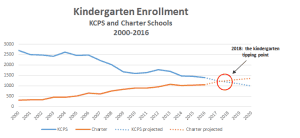What can kindergarten enrollment numbers tell us about the health of our public schools sector, and the future of public education in our school district?
A lot.
First, the facts. Below are the kindergarten enrollment numbers for all public schools within KCPS boundaries – both KCPS and charter – from the 1999-2000 school year (the first year charter schools operated in Kansas City) through the current 2015-16 academic year.
Kindergarten Enrollment: KCPS and Charter Schools, 2000 – 2016
A few trends pop out immediately:
1) There are fewer kindergarten students enrolled in our public schools today – whether KCPS or charter – than in 2000. About 20 percent fewer. Whether this drop is due to families moving outside of KCPS boundaries in search of better schools or because they’re enrolling their children in private schools, the decline is a loss for public education in our school district.
(Note: charter schools are public schools. So when a student leaves KCPS for a charter school, he or she is still in our public schools sector – a win, overall, for public education in our district).
2) Kindergarten enrollment in KCPS schools has declined by almost half since 2000. In 2000, KCPS enrolled 90% of the overall kindergarten market (2,696 of 3,012 students). By 2015-2016, KCPS enrollment dropped to 57% of the kindergarten market (1,404 of 2,461 students).
3) Kindergarten enrollment in the charter sector has grown by 200 percent since 2000. In 1999-2000, charters enrolled 10% of our kindergarten market (316 of 3,012 students). By 2015-16, charter enrollment had grown to 43% of the market (1057 of 2,461 students).
In summary, kindergarten enrollment more or less mirrors what’s happening with our school district as a whole: fewer families are choosing public schools. Of those that do, an increasing number are attending charters.
So what does this mean for our school district going forward?
In my last post, I wrote about kindergarten being an important year: it’s the first touch most of us have with the education system, the beginning of the K-12 pipeline, and the least expensive time for a school to acquire a student.
All of this makes kindergarten a strategic year for school recruitment – and a valuable predictor of future enrollment trends for our district as a whole.
Here’s a picture of the kindergarten enrollment data I shared at the beginning of this post, this time projecting out future kindergarten enrollment based on historical data.
Without taking a close look at the data it’s easy to assume that KCPS will always be the dominant operator in our public schools sector; right now, in March 2016, it serves the majority of kindergarten students in our district.
But KCPS has been pretty steadily losing kindergarten enrollment over the years. If this trend continues it’s quite possible that by 2018 there will be more kindergarten students enrolled in charter schools than in KCPS schools. This isn’t some point off in the distant future – it’s just two years away.
(This 2018 forecast is a straight-line projection based on the past 17 years of kindergarten enrollment data, when charters began operating in our school district. If we make a projection based on only the last five years of enrollment data, starting with the 2011-2012 school year, the tipping point is pushed out to 2019, about three years away.)
So is kindergarten enrollment giving us a preview of what’s to come? Are we heading toward an all-charter school district – but by accident, rather than design?
Possibly, yes. But it’s not inevitable.
Because this analysis of kindergarten enrollment offers one important focal point – a very practical and specific lens – through which to evaluate the recently approved KCPS Master Plan.
Given the strategic value of kindergarten as a recruitment year – and with four new charter elementary schools opening next year within our district boundaries, creating 250+ new kindergarten seats – does the Master Plan do enough to make KCPS schools competitive in this earliest grade?
Up next…Kindergarten Math, Part III: Raising the Bar